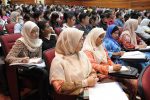
The medical team consists of various professionals who have their own duties and without whom the team would not function well.
One essential part of any medical facility is nurses as they are the first-line of care.
So as to be a good nurse, you need to possess a vast array of medical skills in combination with personal characteristics such as compassion, multi-tasking, and collaborating with other health professionals.
When the job prospect is in question, according to the Bureau of Labor Statistics, registered nurses should not worry, as the job growth is faster than average.
In the years to come, job opportunities are projected to increase by 26%.
Furthermore, better job opportunities will be for those nurses, who become more specialized.
And not only will they increase their chances of securing employment, but also will get higher salaries.
One way in which they can improve their status is in sonography.
Nurses who gain sonography skills can work in hospitals, clinics, or other healthcare facilities.
They are trained to use ultrasound technology for limited obstetric (pregnancy) examinations and peripheral IV insertions.
Limited Obstetrical Ultrasound
If you consider becoming trained to perform limited obstetrical ultrasounds, you will become a nurse that can work in an obstetric or gynecologic (OB/GYN) healthcare setting, no matter whether it is a pregnancy center, OB/GYN clinic, hospital, or another setting.
It is important to mention that a limited ultrasound differs from a basic or standard ultrasound.
Actually, it only targets certain areas and is not a full exam.
In case a woman comes to a limited obstetrical ultrasound, she can get the answers to the following three questions: “Is there a baby in the uterus? Roughly how old is the baby? Does the baby have a heartbeat?”
According to the Association of Women’s Health, Obstetric, and Neonatal Nurses’ claims (AWHONN), a limited exam may also be used to estimate the amount of amniotic fluid in the uterus and to evaluate the cervix.
The main purpose of a limited obstetrical ultrasound is to help potential mothers make an informed decision once pregnancy is confirmed.
Actually, a limited examination can be performed to confirm fetal heart activity in a bleeding patient or to verify fetal presentation in a laboring patient.
If you are now a nurse who wishes to perform ultrasounds in an OB/GYN setting, it is good to remember that you must complete a relevant training course that includes at least 8 hours of didactic instruction followed by hands-on experience under clinical supervision to reach this position.
Furthermore, after the training, you must be continuously monitored by qualified supervisors in their professional OB/GYN setting.
The Jefferson Ultrasound Research and Education Institute (Thomas Jefferson University) offers two-day training courses in Limited Obstetric Ultrasound both at its home base in Philadelphia and in various cities around the U.S.
The National Institute of Family and Life Advocates (NIFLA) also offers three-day courses which are designed for nurses, medical directors, assistants, and midwives who work in pregnancy resource centers.
There are also some colleges, universities, and teaching hospitals or clinics that offer limited ultrasound continuing education courses.
Ultrasound-Guided Peripheral IV Placement
Guided Peripheral IV Placement is a relatively new procedure in medical settings.
What these professionals do is insert peripheral intravenous (PIV) catheters or lines using ultrasound technology as a guide.
Sonography is used to direct the process and it enables smoother PIV insertion in order to avoid possible complications.
It also facilitates the insertion when blood vessels are difficult to locate.
So as to become a nurse who can perform this procedure, you have to be properly trained.
Those who know how to successfully perform ultrasound-guided PIV insertion may use this skill in a variety of settings, from emergency rooms to intensive care units.
“In the emergency department and in the various intensive care units, these nurses use ultrasound to assess the bladder before placing a catheter to ensure adequate volume will be returned.
The University of California, Irvine, is one of several universities or schools of medicine/health that offer training for nursing students on how to perform ultrasound-guided PIV insertion.
At some educational institutes, you can enroll in continuing education courses that teach these particular sonography skills.
Also, SonoSite, Inc. offers two-hour workshops entitled “Introduction to Ultrasound-Guided Peripheral IV Placement” in numerous cities across the country.
Due to the fact that ultrasound technology and techniques are continuously evolving and improving, nurses will have the potential to acquire and practice even more ultrasound procedures and improve their job prospects and earnings.








